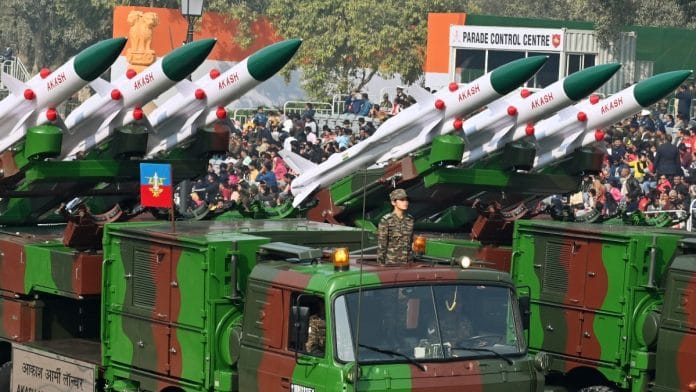New Delhi: The Army and Air Force (IAF) are working towards combining air defence operations in a move aimed at achieving jointness—integration of different branches of the armed forces. To this effect, ThePrint has learnt that the Army’s Akashteer air defence system has been integrated with the Integrated Air Command & Control System (IACCS) for one site. For other sites, integration is said to be in progress.
The Chief of the Army Staff Gen Upendra Dwivedi during his annual press conference Monday said, “To carry out a convergence between the Indian Air Force and Army, we are going in for Akashteer and probably by year-end, we will be having due integration between the two—that is the IACCS and Akashteer.”
The Army requires a total of 455 Akashteer systems. Of these, 107 have been delivered, 105 are expected by March 2025, while delivery of the remaining systems by state-run Bharat Electronics Limited (BEL) is expected by March 2027.
As part of the effort to move in the direction of jointness, all Army radars will be integrated through Akashteer at the Joint Air Defence Centre (JADC) level, it is learnt.
Currently, a number of IAF radars and civil radars are interconnected through IACCS. For a comprehensive airspace coverage, more radars woven in one network become imperative. Hence, the addition of Army radars would only bolster the defence of India’s sovereign airspace. Post the integration, IAF will be in-charge of the safety of the integrated air defence umbrella, given that longer-range systems are primarily operated by it.
During the press conference Monday, Gen Dwivedi also said the Army is looking at procuring VSHORAD (Very Short Range Air Defence System) in the immediate time frame. He added that the Army is working in conjunction with the IAF.
Gen Dwivedi also said that moving forward, the forces will have to operate air defences together. The Army should control it at the tactical level and the IAF at the operational/strategic level, he said. “As far as radars are concerned, these will be placed jointly by the two and the information will be jointly shared.”
Common systems the Army and IAF operate currently are Medium Range Surface to Air Missile (MRSAM) and the Akash air defence system. The IAF also operates the S-400 which is a long-range missile system. MRSAM has a range of 70 km and Akash of 25 km. The systems include acquisition and tracking radars—Akash is equipped with the Rohini radar, while MRSAM uses the Multi-Functional Search and Target Acquisition Radar (MFSTAR).
Under the integrated air defence umbrella, missiles as well as radars will be integrated.
On why the need for jointness in air defence was felt, sources in the Indian Air Force told ThePrint that jointness of the armed forces was “essential at strategic, operational and tactical level”. They added that it ensured “optimal and finest” utilisation of available air defence resources. The two services, said sources, are currently working on upgrades and establishment of networks for data sharing. With an eye on jointness, armed forces would also get all future air defence inventories interoperable as it supports enhanced interoperability by enabling networking and joint planning—a prerequisite for theatrisation.
Also Read: Complex network of India’s existing air defence capabilities & the way forward
Ongoing effort since 2018
The IAF and Army started the process of combining their air defences in June 2018.
A Joint Service Study Group (JSSG) was constituted to study the employment of Ground Based Air Defence Weapon Systems (GBADWS) of all services with the view to “optimise their employment, achieve inter service synergy and ensure requisite protection of all vital assets against aerial threats”. The JSSG is commissioned at an interval of 8-10 years.
In 2020, then Chief of Defence Staff (CDS) Gen Bipin Rawat had called the integration of air defence “low hanging fruit”. At the time, there was talk of a separate air defence command. But no such development has been confirmed as yet, mainly because the theatre command concept is still in the works.
Sources in the defence establishment informed ThePrint that the combination of air defence assets will have an impact on peacetime and wartime air defence operations. “It provides a comprehensive air defence deployment and a robust employment philosophy to tackle the growing threat both during operations as well as peacetime,” a source said.
On integration during peacetime, the source said live threats such as drones being used to drop arms, ammunition, and drugs have emerged as a matter of concern in recent years. “The air defence threat has therefore spilled over into the peacetime domain as well.”
One recent example is that of Manipur, where a large number of high-tech drones were used to carry out bombing attacks that have aggravated the grey-zone threat. The current environment of an expanding air defence threat underscores the necessity to pool in resources of all services together, said another source.
Combining of air defence assets comes in the backdrop of the Balakot air strikes, where for a few subsequent months following the airstrikes, Army radars plugged into the IAF air defence system radars. It was after this that the two forces began integrating their air defence operations, which would help in wartime or Balakot-like situations arising in the future. This would ensure a gap-free radar system and in turn, missile deployment.
(Edited by Amrtansh Arora)
Also Read: ‘Joint culture needed first’ — CDS Gen Chauhan outlines first steps on the road to theaterisation






